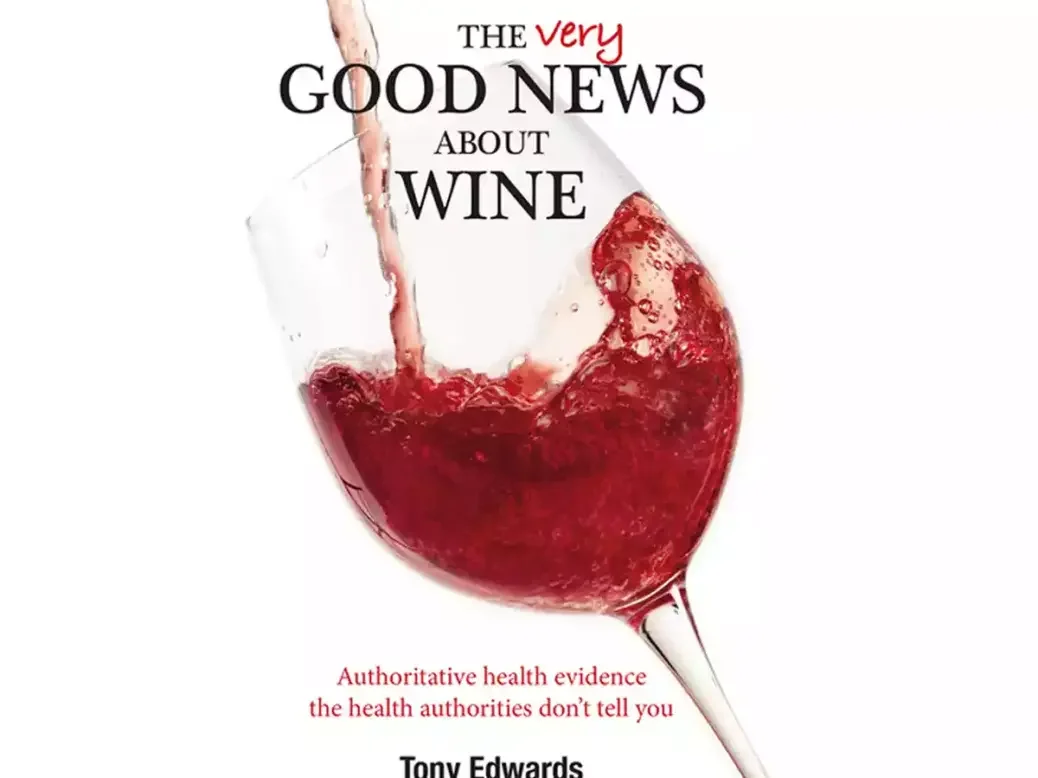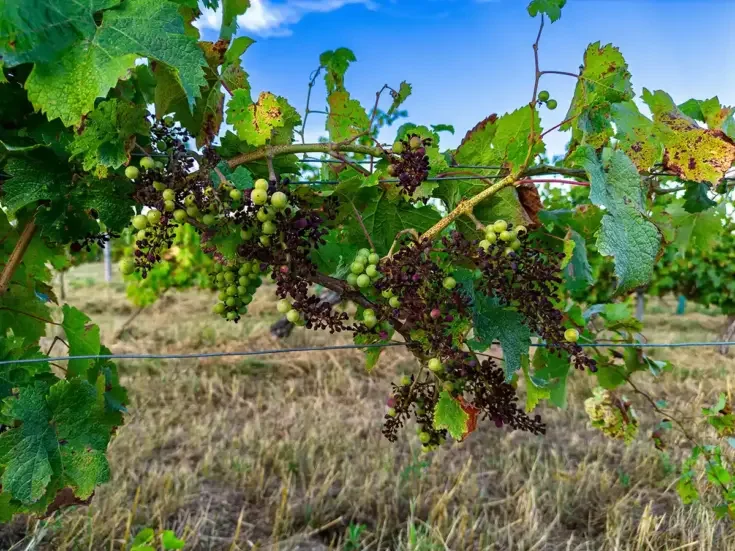
Dr Erik Skovenborg reviews The Very Good News about Wine by Tony Edwards.
The small size of The Very Good News about Wine—5 x 0.4 x 8 inches (12.7 x 1.04 x 20cm)—belies the sheer volume of information to be found on its 171 pages. Drawing on the evidence from 340 references, the book covers all imaginable wine and health issues—from the big C (cancer), to the small c (common cold). This conscientious examination of what the science really says about the health effects of alcohol consumption in general, and of wine in particular, is no small feat; to be able to cut through the fog of contradictory stories about alcohol and health, you need to have an encyclopedic knowledge of thousands of studies.
In Tony Edwards’s latest book, chapter 3 (Heart Disease), chapter 4 (Diabetes), and chapter 5 (Dementia) are classical health issues, where the solid evidence of a beneficial effect of moderate wine consumption is presented and several backlashes are dealt with. Chapter 10 (Living Longer) is enjoyable reading and gives hope to those who wish to grow old in good company with their well-stocked cellar. Here, however, I will dwell a little longer on chapters 2 (The Big C) and 14 (Dis- Mis- and Mal- Information), which is where you really get your money’s worth as a wine drinker. Tony Edwards is not afraid to grasp the nettle and address thorny alcohol and health problems head on. The Very Good News About Wine is important reading—content that you will not find anywhere else and a veritable antidote to the 21st-century “Prohibition” campaign.
The Big C
Some cancers are more closely associated with alcohol consumption than others, and this is certainly a serious problem. Among the good news these days is a 98.3 percent survival rate for stage 1 breast cancer, but the widespread fear of cancer in general, and breast cancer in particular, seems to be used by cancer societies as a means to an end: “Even drinking small amounts of alcohol has been linked with an increase in risk. It is better not to drink alcohol at all.” So, let’s take a look at the evidence for a causal association of “small amounts of alcohol” and risk of breast cancer.
- There is substantial heterogeneity of estimates across studies of alcohol and breast cancer, especially studies of light alcohol consumption. My own review of the literature found as many as 75 case-control studies and 32 cohort studies showing no or nonsignificant associations between alcohol intake and breast cancer incidence or mortality.
- Most studies have no information about drinking patterns; so, for example, the risk of women drinking 70g alcohol/week is presented as the risk of drinking 10g/day. What kind of drinking is actually being described when averages per day are the basis of classification—someone who is drinking a little every day or someone who is drinking a lot once a week? (G Knupfer, “Drinking for health: the daily light drinker fiction,” British Journal of Addiction 82, 1987, pp.547–55.)
- A recent review defined a healthy drinking habit score (DHS) by regular drinking (frequency of alcohol intake ≥ three times/week) and consuming alcohol with meals. Moderate alcohol intake (50–200g/week) was not associated with cancer mortality in participants with a favorable DHS. (H Ma et al, “Alcohol consumption levels as compared with drinking habits in predicting all-cause mortality and cause-specific mortality in current drinkers,” Mayo Clinic Proceedings 96, 2021, pp.1758–69.)
- The results of many studies suggest a protective effect of a “magic B vitamin supplement” for female wine drinkers. This information is nowhere to be found in the “No safe level” material from the WHO or national cancer societies, but you will find all you need to know about it in “Folate Magic,” chapter 2 of Tony Edwards’s book.
The “No safe level” mantra
“We cannot talk about a so-called safe level of alcohol use. It doesn’t matter how much you drink—the risk to the drinker’s health starts from the first drop of any alcoholic beverage. The only thing that we can say for sure is that the more you drink, the more harmful it is—or, in other words, the less you drink, the safer it is,” asserts Dr Carina Ferreira-Borges, Regional Advisor for Alcohol and Illicit Drugs in the WHO Regional Office for Europe. “To identify a ‘safe’ level of alcohol consumption, valid scientific evidence would need to demonstrate that at and below a certain level, there is no risk of illness or injury associated with alcohol consumption. The new WHO statement clarifies: currently available evidence cannot indicate the existence of a threshold at which the carcinogenic effects of alcohol ‘switch on’ and start to manifest in the human body.”1
While the “No safe level of alcohol intake” mantra might be technically true, it is also absurd, in that no human activity has zero risk. To understand why, you need to know something about the principles of risk—a mathematical dark art that sits at the heart of the health-anxiety industry. The burden of proof is always on the person making an assertion, and the assertion of “no safe level” is nonsense—or worse; coming from the WHO, it is “pseudoscience.” The sound systematic principles of observation, analysis, and conclusion-making that are inherent in scientific methodologies will never be able to show that a risk is zero. What kind of magic study could the WHO suggest that would be able to deliver “valid scientific evidence” that at and below a certain level, there is no risk of illness or injury associated with alcohol consumption?
A safe level of flying?
Let’s move from fear of cancer to fear of flying, which is more common than you might think. In the 1988 film Rain Man, Charlie’s autistic brother Raymond, played by Dustin Hoffman, refuses to fly to Los Angeles, mentioning several prominent plane crashes. One airline, however, seems to be safe: “Qantas never crashed,” says Raymond. And Qantas does indeed have a very strong safety record—but no airline can guarantee aerophobia sufferers a safe level of flying where accidents will never occur. According to the 2022 Safety Report for global aviation released by IATA, on average a person would need to take a flight every day for 25,214 years to experience a fatal accident.
While no safe level of flying can be proven, if we wish to get from point A to point B, be it for business or pleasure, the very small risk should allow us to sit back, relax, and enjoy the flight. The nonsensical “No safe level” mantra ignores the positive reasons people drink. Presumably those who choose to drink wine derive some pleasure from it, and any supposed risk needs to be traded off against this enjoyment. If you disagree that universal abstinence is a desirable, ethically justified, and scientifically defensible aspiration, The Very Good News about Wine is the perfect book for your next vacation.
Dis- Mis- and Mal- Information
“None seemed to think the injury arose from the use of a bad thing, but from the abuse of a very good thing,” Abraham Lincoln said 160 years ago. Now listen to Dame Sally Davies, the UK’s former Chief Medical Officer, who in 2016 was prepared to dismiss as an “old wives’ tale” the convincing evidence from more than 40 years of observational studies that drinking a glass of red wine a day is good for you. Sally Davies even suggested that we should think about cancer every time we consider having a glass of wine. “She is drunk on risk,” was the observation of a researcher from the University of Basel (DM Shaw, “Drunk on risk: how the chief medical officers’ alcohol guidelines are demonising drink,” British Medical Journal 352, 2016, i1175)
What Dame Sally Davies and Dr Ferreira-Borges have in common with colleagues in the neo-temperance lobby is leading positions in public health departments and NGOs for alcohol use disorders. Above all, they have the large global health and economic burden of alcohol consumption in mind. In the presence of strong opinions and beliefs in the field of alcohol exposure and public health, there is a risk that a review of relevant scientific literature may be inspired by the opinions of public health officers picking the results of analyses that best fit their preconceived theories. “White Hat Bias” (WHB) leads to the distortion of information in the service of what may be perceived to be righteous ends. In this case, WHB may be fueled by feelings of righteous zeal, indignation toward certain aspects of the alcohol industry, or any of several other factors.
It is not proof of bias to be concerned about the toxicity of alcohol, or to be skeptical about the claims of beneficial health effects of moderate alcohol consumption. Bias occurs when concern and skepticism are applied selectively to alcohol consumption as a risk factor, while at the same time embracing findings regarding, for example, obesity, exercise, or consumption of fruits and vegetables from the same type of epidemiological studies. The mindset of WHB may lead to a reasoning along these lines: “If people read how healthy wine really is, they would drink themselves to death.”
A little of what you fancy
As wine editor of Gourmet magazine for more than 30 years, Gerald Asher possessed a profound knowledge of wine, wineries, and vineyards. “A little of what you fancy” is the title of a dinner speech that he gave at the Wine, Health, and Society Symposium in San Francisco on November 13–14, 1981. “Since this is a seminar dedicated to the scientific understanding of wine and medicine, let me confess right away,” he said, “that I do not drink wine for subversive purposes like improving my rate of high-density lipoproteins or helping my digestive system extract more nutrients from food. I drink wine because I like it, it makes me happy, and it encourages me to like my fellow men.”
Perhaps public health policy should build on the healthy uses to which most people put alcohol. Unfortunately, the report on guidelines in chapter 14 of The Very Good News about Wine indicates that we are far from that ideal scenario, so we need information from Tony Edwards and other outspoken critics of the “No safe level” establishment to balance the medical views on our favorite tipple. ▉
1 who.int/europe/news/item/04-01-2023-
no-level-of-alcohol-consumption-is-safe-for-our-health#:~:text=Risks%20Start%20from%20The%20First%20Drop
The Very Good News about Wine
Tony Edwards
Self-published; available on amazon.com / 171 pages; £12.99







